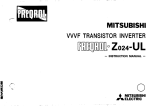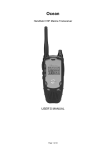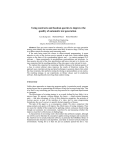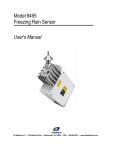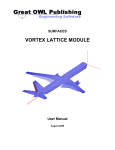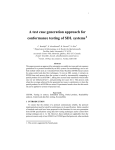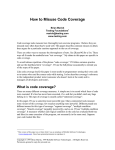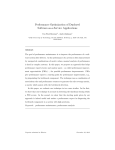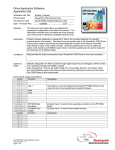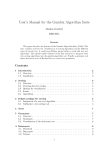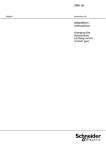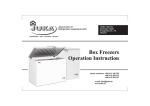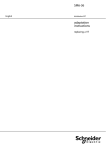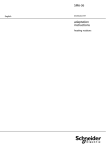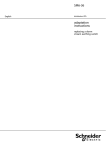Download An applicable family of data flow testing criteria
Transcript
IEEE TRANSACTIONS ON SOFTWARE ENGINEERING, VOL. 14. NO. IO, OCTOBER 19x8
1483
An Applicable Family of Data Flow Testing Criteria
PHYLLIS G. FRANKL
AND
Abstract-A test data adequacy criterion is a predicate which is used
to determine whether a program has been tested “enough.” An adequacy criterion is applicable if for every program there exists a set of
test data for the program which satisfies the criterion. Most test data
adequacy criteria based on path selection fail to satisfy the applicability property because, for some programs with unexecutable paths, no
adequate set of test data exists.
In this paper, we extend the definitions of the previously introduced
family of data flow testing criteria to apply to programs written in a
large subset of Pascal. We then define a new family of adequacy criteria called feasible data flow testing criteria, which are derived from
the data flow testing criteria. The feasible data flow testing criteria
circumvent the problem of nonapplicability of the data flow testing criteria by requiring the test data to exercise only those definition-use
associations which are executable. We show that there are significant
differences between the relationships among the data flow testing criteria and the relationships among the feasible data flow testing criteria.
We also discuss a generalized notion of the executability of a path
through a program unit. A script of a testing session using our data
flow testing tool, ASSET, is included in the Appendix.
Index Terms-Data
tion.
flow analysis, software testing, software valida-
I. INTRODUCTION
N important problem in software testing is deciding
when to stop. An adequacy criterion is a predicate
which is used to determine whether a program has been
tested “enough. ” Several software test data adequacy criteria are based on the idea that one cannot consider a program to be adequately tested if certain sequences of statements have never been executed by any test data. These
methods generally associate a test set T , which is a subset
of the input domain of the specification of a program P ,
with the set II of paths through P’s flow graph, which are
executed when the program is run with inputs from T. The
test set T , or equivalently the set of paths II, is said to
satisfy criterion C for programs P ( “ T is C-adequate for
P”) if and only if each of the sequences required by C is
a subpath of one of the paths in II.
The most well known of these criteria are statement
testing, branch testing, and path testing, which require
that the test data cause every node, branch, or path, respectively, in the program’s flow graph to be executed
A
Manuscript received September 15, 1986. This research was supported
in part by the National Science Foundation under Grant DCR8501614 and
by the Ofice of Naval Research under Contract N00014-85-K-0414,
P. G. Frank1 is with the Department of Electrical Engineering and Computer Science, Polytechnic University, Brooklyn, NY 11201.
E. J . Weyuker is with the Department of Computer Science, Courant
Institute of Mathematical Sciences, New York University, New York, NY
10012.
IEEE Log Number 8823071,
ELAINE J. WEYUKER
[ 1 1 3 , [ 121. Unfortunately, statement and branch testing
can fail to expose matly common errors, and path testing
is usually infeasible since programs with loops have infinitely many paths [7], [lo]. Several criteria which are
based on analysis of the program’s control flow and which
are stronger than branch testing but weaker than path testing have been proposed [ 1 I], [ 151, [23].
Recently, a number of test data adequacy criteria which
are based on data flow (DF) analysis, some of which
“bridge the gap” between branch testing and path testing, have been proposed and studied [l], [9], [14], [161,
[ 181, [ 191. Tools based on some of them have been implemented [2], [3], [6], 1133. These criteria are based on
the intuition that one should not feel confident that a variable has been assigned the correct value at some point in
the program if no test data cause the execution of a path
from the assignment to a point where the variable’s value
is subsequently used.
All of these criteria suffer from the weakness that for
programs with unexecutable paths it may be impossible
for any test set to satisfy the given adequacy criterion. For
example, consider a program containing the statement
“for i : = 1 to 5 do S.” For each n 1 0, there is at least
one path through the program’s flow graph which traverses the loop n times. However, those paths corresponding to n # 5 can never be executed. Such a program
could not be adequately tested using the path testing criterion, even if it were possible to do exhaustive testing.
Experience using our tool, ASSET, has shown that, for
many programs, unexecutable paths make it impossible
for any test to satisfy a given DF testing criterion [2], [3].
This is clearly an undesirable situation.
An adequacy criterion C satisfies the applicability
property if and only if for every program P there exists
some test set which is C-adequate for P [22]. One would
expect a “good” adequacy criterion C to satisfy the applicability property. However, the statement testing,
branch testing, path testing, and DF testing criteria all fail
to satisfy the applicability property. Furthermore, for each
of them it is undecidable whether a test set exists which
adequately tests a given program.
One way to enforce the applicability of a criterion C is
to restrict the class of programs considered to A,, the set
of programs for which there exists a C-adequate test set.
Unfortunately, for each DF testing criterion C (as well as
the other criteria mentioned above), A , excludes many
“typical” programs. Furthermore, it is undecidable
whether a given program belongs to A,. These drawbacks
lead us to reject this approach. Instead, we define a new
0098-5589/88/1000-1483$01 .OO 0 1988 IEEE
1484
IEEE TRANSACTIONS ON SOFTWARE ENGINEERING, VOL. 14, NO. IO, OCTOBER 1988
family of adequacy criteria by modifying the old criteria
so as to ensure applicability.
In this paper, we define a new family of adequacy criteria, which are derived from the DF testing criteria proposed in [18], [I91 and which satisfy the applicability
property. Roughly speaking, for each of these new criteria, a test is adequate if and only if it comes “as close as
possible” to satisfying the corresponding DF testing criterion. These criteria will be defined precisely, and the
relationships between them will be explored in Section
111. In Section 11, we summarize the theory of DF testing,
extending it to apply to programs written in Pascal. In
Section IV, we define and discuss a generalization of the
new family of criteria which takes into account information about the context in which the subprogram being
tested is called.
11. DEFINITIONS
OF THE DF TESTING
CRITERIA
A family of test data adequacy criteria, based on analysis of the DF characteristics of the program being tested,
was defined in [18]. These criteria, which we call datu
flow testing criteria, or DF testing for short, were originally defined for a very simple universal programming
language consisting of assignment statements, conditional
and unconditional transfer statements, and I/O statements. They require that the test data exercise certain
paths from a point in a program where a variable is defined to points where the variable is subsequently used. A
tool, ASSET, which performs DF testing on programs
written in such a language, is described in [2].
In order to make DF testing more practical, we have
extended it to apply to a large subset of Pascal and have
enhanced ASSET accordingly. The basic ideas behind DF
testing apply to testing programs written in other imperative languages, but for precision it is necessary to specify
a particular syntax. We now summarize the extended theory of DF testing.
We apply DF testing to an individual subprogram, i.e.,
a main program, a procedure, or a function. To execute a
procedure or function P , we must call it from a driver
program. Thus, to test a procedure or function P , we need
a test-set/driver-progrum pair ( T , D ) where D is a program which might call P and T is a subset of the input
domain of the specification for D.Obviously, the path (or
paths) through P which is executed when a particular test
case is input to D will depend on D , as well as on the test
case. We will often omit reference to the driver program
when it is obvious which driver program is calling the
subprogram. Similarly, we may omit reference to the
driver program if it simply reads in the arguments to the
subprogram in order and then calls the subprogram once.
As a technical convenience, we assume that the subprogram being tested has no goto statements, no with statements, no variant records, no functions having var parameters, no procedural or functional parameters, and no
conformant arrays. It would not be difficult to relax these
assumptions. We also assume that in every conditional
statement the Boolean expression which determines the
flow of control has at least one occurrence of a variable
or a call to the function eofor to the function eoln.
A subprogram can be uniquely decomposed into a set
of disjoint blocks of statements. A block is a maximal
sequence of simple statements having the properties that
it can only be entered through the first statement and that,
whenever the first statement is executed, the remaining
statements are executed in the given order. The subprogram to be tested is represented by aflow graph in which
the nodes correspond to the blocks of the subprogram and
edges indicate possible flow of control between blocks.
As a technical convenience, some nodes which correspond to empty sequences of statements may also be added
to the flow graph. Fig. 1 shows the subgraphs corresponding to statements in the language. The subprogram’s flow
graph is obtained by merging the exit node of each statement with the entry node of the following statement. An
entry node preceding the first statement of the procedure
and an exit node succeeding the last statement are added.
DF analysis was originally used for compiler optimization [8], [20]. It generally classifies each variable occurrence as being a definition, in which a value is stored
in a memory location, a use, in which a value is fetched
from a memory location, or an undefinition, in which the
value and the location become unbound. For our purposes, we will also distinguish between two different types
of use. The first type directly affects the computation being
performed or outputs the result of some earlier definition.
We call such a use a computation use, or a c-use. Of
course, a c-use may indirectly affect the flow of control
through the subprogram. In contrast, the second type of
use directly affects the flow of control through the subprogram, and thereby may indirectly affect the computations performed. We call such a use a predicate use or p use.
We will associate a sequence of definitions and c-uses
with each node in the flow graph and will associate a set
of p-uses with each edge in the flow graph. Fig. 1 shows
the classification of variable occurrences in the language’s
statements. In addition, the entry node is considered to
have a definition of each parameter, each nonlocal variable which occurs in the subprogram, and the input buffer
inputt, which may implicitly occur in calls to the standard
procedures/functions read, readln, eoln, and eof. The exit
node has an undefintion of each local variable, a c-use of
each variable parameter, a c-use of each nonlocal variable, and a c-use of the input buffer inputt.
We now discuss how DF analysis is handled for structured variables. Since it is not possible, in general, to determine the particular array element which is being defined or used in an occurrence of an array variable, any
definition of the variable a [ e ] will consist of a c-use of
each variable occurring in the expression e , followed by
a definition of a . Any use of a [ e ] will consist of uses of
all of the variables occurring in e , followed by a use of a.
Similarly, we will treat pointers purely syntactically,
making no attempt to perform DF analysis on dereferenced pointers. If p is a pointer variable, a definition of
1485
FRANKL AND WEYUKER: DATA FLOW TESTING CRITERIA
for ertmtcmen1:
for v:=el to e2 do S;
for v:= el downto e2 do S;
read(v1,. ...vn);
readln(v1. ....vn);
read(f,vl,. ..,vn) ;
readln(f,vl, ...,vn);
I
1
I
;
Let tmp be a new variable.
Let f and g be the entry
and exit nodes, resputivcly,
Of S. NO& h h u C-UKS Of
each vuiable in el,
__.___._..._._..__..~...~~~
.~
-.-~
followed
by a definition
of v and I
c-uses of each v u i i b l e in e2
I
write(e1,. ..,en) ;
writeln(e1, ....en);
followed by idefinitionof mp. 1
Edges (i,f) and (i,j) have
I
write(f,el, ...,en);
p-uses of v and tmp. Node g h u
writeln(f ,el ,....en);
a E-IJSC followed by a def of V.
I
1- - -.------___-__--.-______r_______________...~~
Node i has c-uses of each variable occurring in el,...,en. I
If the file variable f is present then node i
r e p u t ertattment:
also bas a definition followed by a c-use of ft.
rcpcdt SI; ;Sa until B;
I
. . . . . . . . . . . . . . . . . . . . . . . . . . . . . . . . . . . . . . . . . . . .
Node i has definitions of v l , ...,vn.
If the file variable f ia present then node i
also has a c-use followed by a definition of fl.
I - - - -
;
'
'
I
~
. . . .
...
Procednre call: P(e1, ...,en);
~
I
I
t
Node j has c-uses of each variable occuring in
the expressions el,...,en.
Tbese are followed by definitions of each actual
parameter which corresponds to avar formal parameter.
1
Nodes i and k are included to assure that
the procedure call has it8 own node.
I
I
.
Let j be the entry node of
S1, and let k be the exit
node of Sn.
Edges (k,j) and (k,i) have
p-useer of each variable in
the boolean expression B.
.
.
.
.
.
.
.
.
.
.
.
.
.
.
.
.
.
.
.
.
.
.
.
.
.
.
.
.
.
.
.
.
.
.
.
.
.
.
.
.
.
.
.
.
.
.
;
,
;
.
CONDITIONAL STATEMENTS
I
...............................................
if-then-else statement
if B then S1
S1;else SZ;
Let k and j be the entry nodes of
S1 and SZ, respectively.
Edger (i,j) and (i,k) have
p-uses of each variable in the
boolean expression B.
if there is no "else" part then
subgraph S2 has a single node
corresponding to an empty block.
j
d6b
;
I
~
I
case e l of
label-list1 : S1;
label-listn : Sn
end;
Let j l , ...,jn be the entry nodes of
S1,...,Sn, respectively.
I
;
Edges (i.jl) ,...,(i,jn)
have p-uses of each variable
in the expression e l .
..............................................
Fig. 1. Control flow and DF for statement in the language.
the subgraph corresponding to statement Si.
pt consists of a c-use of p followed by a definition of pt,
and a use of p t consists of a use of p followed by a use
of p t . Since it is not possible to determine statically the
memory location to which a pointer points, we will ignore
the definitions and uses of p t .
Each field of a record is treated as an individual variable. Any unqualified occurrence of a record is treated as
an occurrence of each field of the record. Occurrences of
file variables in I/O statements are handled by considering
the effect of the statement on the file buffer.
Note that our model of data flow may not reflect the
SiQdenotes
actual DF in the subprogram being tested completely accurately. For example, we have made no attempt to perform any interprocedural data flow analysis, have ignored
dereferenced pointers, have made no attempt to disambiguate array references, and have ignored potential
aliasing and side effects. In an optimizing compiler, it is
imperative that conservative assumptions be made about
the flow of data, lest a code transformation which changes
the semantics of the program be performed. In the context
of DF testing, however, such caution is not strictly necessary. On the other hand, it seems reasonable to expect
1486
IEEE TRANSACTIONS ON SOFTWARE ENGINEERING, VOL.
that more accurate DF analysis will force the selection of
better test data. In [ 3 ] , we compare the test data needed
to test programs adequately when each array is treated as
a single entity to the test data required to test transformed
programs adequately in which array references are disambiguated and each element of the array is treated as an
individual entity. More exploration of the tradeoff between the difficulty of performing accurate DF analysis
and the quality of the resulting test data is needed.
We are interested in tracing the flow of data between
nodes, and thus define a c-use of a variable x in node i to
be a global c-use if the value of x has been assigned in
some block other than block i. Let x be a variable occurring in a subprogram. A path ( i , n l , * * , nnj,j ), m 2
0, containing no definitions or undefinitions of x in nodes
nl,
. , n ,,, is called a dejinition clearpath with respect
to x (def-clear path wrt x ) from node i to node j and from
node i to edge (n,,,, j ). A node i has a global definition
of a variable x if it has a definition of x and there is a defclear path wrt x from node i to some node containing a
global c-use or edge containing a p-use of x . Since every
p-use is associated with a potential transfer of control from
one node to another, there is no need to distinguish between p-uses and global p-uses.
We restrict the class of subprograms to which DF testing applies to those subprograms P satisfying the following two properties.
1 ) No-Syntactic-Undejined-P-useProperty (NSUP):
For every p-use of a variable x on an edge ( i , j ) in P ,
there is some path from the start node to edge ( i ,j ) which
contains a global definition of x .
2) Non-Straight-Line Property (NSL): P has at least
one conditional or repetitive statement.
Note that the NSL property guarantees that at least one
node in P ’ s flow graph has more than one successor and
that at least one variable has a p-use in P.
The subprogram’s def-use graph is obtained from the
flow graph by associating with each node i the sets
c-use ( i ) = {variables which have global c-uses in block
i } and d e f ( i ) = { variables which have global definitions
in block i } and associating with each edge ( i , j ) the set
p-use ( i , j ) = {variables which have p-uses on edge ( i ,
j ) }. We also define sets of nodes dcu(x, i ) = { nodes j
such that x E c-use ( j ) and there is a def-clear path with
respect to x from i to j } and dpu ( x , i ) = { edges ( j , k )
such that x E p-use ( j , k ) and there is a def-clear path with
respect to x from i to ( j , k ) } . These definitions are summarized in Fig. 2 .
Thus, if x E d e f ( i ) a n d j E dcu(x, i ) , then x has a
global definition in node i and a c-use in nodej, and there
is a definition clear path with respect to x from node i to
node j . Therefore, it may be possible for control to reach
node j with the variable x having the value which was
assigned to it in node i.
A dejinition-c-use association is a triple ( i ,j , x ) where
i is a node containing a global definition of x and j E
dcu(x, i ) . A definition-p-use association is a triple ( i ,
( j , k ) , x ) where i is a node containing a global definition
-
--
14.
NO. IO. OCTOBER 1988
= the set of variables
= the set of nodes
thc set of edges
= ( x E V I x has a global definition in block i )
= (x E V I x has a global c-use in block i )
= ( x e VI xhasapuseinedge(ij))
=
= [j E
N I x E c-use(i) and thcrc is a def-clear path wrt x from i to j)
E E I x E p-use(i&)and therc is a def-cleax path wrt x from i to (j,k) )
= (U&)
Fig. 2. Definitions.
of x and ( j , k ) E dpu(x, i ). A simple path is one in which
all nodes, except possibly the first and last, are distinct.
A loop-free path is one in which all nodes are distinct. A
path ( n l , * * , n,, nk) is a du-path with respect to a variable x if n1 has a global definition of x and either
1) n k has a global c-use of x and ( n l , * * . , nj, n k ) is a
def-clear simple path with respect to x, or
2 ) ( nj, nk) has a p-use of x and ( n l , . * , n j ) is a defclear loop-free path with respect to x .
An association is a definition-c-use association, a definition-p-use association, or a du-path.
A complete path is a path from the entry node to the
exit node of the flow graph. A complete path a covers a
definition-c-use association ( i ,j , x ) [respectively, a definition-p-use association ( i , ( j , k ) , x ) ] if it has a definition clear subpath with respect to x from i to j [ respectively, from i to ( j , k ) ] . a covers a du-path a‘ if a’ is a
subpath of a. A set II of paths covers an association if
some element of the set does. A test-set/driver-program
pair ( D , T ) covers an association if, when input to D ,the
elements of T cause the execution of the set of paths II,
and II covers the association.
Roughly speaking, the family of DF testing criteria is
based on requiring that the test data execute definition
clear paths from each node containing a global definition
of a variable to specified nodes containing global c-uses
and edges containing p-uses of that variable. For each
variable definition, we can demand that
rS
1 :ie
definition
clear paths with respect to that variable from the node
containing the definition to
[ szie
I
of the [E:s]
p-uses
reachable by some such paths be executed. The criteria
are defined precisely in Fig. 3 .
If variable x has a global definition in node i , the alldefs criterion requires the test data to exercise some path
which goes from node i to some node or edge at which
the value assigned to x in node i is used. The all-uses
criterion requires the test data to exercise at least one path
to each such node and to each such edge. The all-du-paths
criterion requires that all of the du-paths from i to each
such node and each such edge be exercised. The criteria
all-p-uses, all-c-uses, all-p-usedsome-c-uses, and all-cuses/some-p-uses place emphasis on either c-uses or puses. Note that any subprogram has only finitely many
definition-use associations, so none of the DF criteria requires an infinite amount of test data. Upper bounds on
1487
FRANKL A N D WEYUKER: DATA FLOW TESTING CRITERIA
THE DATA FLOW TESTING CRITERIA
ALL-PATHS
A wt-sctldrivcr-program-program
pair (T,D) satisfiescriterion C for subprogram P if and only if
for each node i in P's flow graph and each x E def(i) the set ll of paths executed by T
m v m the following associations:
ALL-DU-PATHS
CRlTERlON
Alldefs
AU-c-uses
All-puses
AU-p-uses/mnc-c-uses
All-c-uscs/some-p-uscs
All-uses
All-du-paths
I
I1
\/
ASSOCIAnONS REQUIRED
Some (ij,x) s.t jsdcu(x,i) or
some
(i.(j,k).x)
s.t.
(j,k)e dpu(x.1).
AU (i j.x) s.t. je dcu(x.i).
All (i,(i,k),x) s.t. (j,k)e dpu(x,i).
All (i,(j,k),x) s.t. (j,k)~dpu(x,i).
In addition, if dpu(x,i)=$ then
some (ij,x) s.t. jadcu(x,i).
Note that since i has a global
delinition of x. dpu(x.i)*
All (ij,x) s.t. jedcu(x,i). In
addition. if dcu(x.ihb
. ., then
some
(i,(j,k),x)
s.t.
.
(j,k)e dcu(x,i). Note that since
i has a global definition of x,
dcu(x,i)=$ + dpu(x,i)#$.
All (ij,x) s.t. j E dcu(x.i) and
all (i,(i,k),x) s.t. (j,k)edpu(x,i).
AU du-paths from i to j with
respect to x for each jcdcu(x,i)
and all du-paths from i to (j,k)
with respect to x for each
(j,k)k)~dpu(x,i).
the amount of test data required by the DF criteria are
established in [2 11.
Criterion C, includes criterion C, if and only if, for
every subprogram, any test-set/driver-program pair which
satisfies C, also satisfies C,. Criterion C, strictly includes
criterion C,, denoted CI * C2, if and only if C, includes
C2 and for some subprogram P there is a test-set/driverprogram pair which satisfies C2 but does not satisfy C , .
The notion of subsumption in [ l ] is similar to our notion
of inclusion.
Rapps and Weyuker proved that for the simple language
for which DF testing was originally defined, the relationship among the criteria is as shown in Fig. 4 [ 191. Clarke
et al. [l] have shown the relationship of the criteria defined by Laski and Korel [14] and Ntafos 1161 to the DF
criteria.
In extending the theory of DF testing to apply to programs written in Pascal, we have preserved the inclusion
relations among the DF criteria. Doing so required the
inclusion of definitions of all nonlocal variables in the entry node of the procedure and careful treatment of implicit
uses of the variable inputt. For symmetry, we have also
added the all-c-uses criterion, which was not defined in
1191. For more details of the proof that the relationship
among the criteria is as shown in Fig. 4 , see [ 5 ] .
111. THE FEASIBLE
DF TESTINGCRITERIA
Given a subprogram P and a DF criterion C,it may be
the case that no test-set/driver-program pair for P satisfies
C. This occurs when none of the paths which cover a particular association required by C is executable. In such a
case, P cannot be adequately tested according to C. In this
section, we introduce a new family of criteria, derived
from the DF criteria, which circumvent this problem, and
,y\
ALL-C-USESISOME-P-USES
,/
ALL-C-USES
J
\
ALL-P-USESISOME-C-USES
,/
ALL-DEFS
J
\
ALL-P-USES
1
I
\/
ALL-EDGES
V
ALL-NODES
Fig. 4. The relationship among the DF testing criteria.
investigate some of its properties. We assume that all
aliasing and side effects are known. We also assume that
no element of the test set causes the program to crash;
thus, if a test case causes the execution of the entry node
of some subprogram, it will cause the execution of a path
from the entry to the exit of that subprogram.
Recall that a complete path is a path from the entry
node to the exit node of a subprogram's flow graph. We
say that a complete path is executable or feasible if there
exists some assignment of values to input variables, nonlocal variables, and parameters which causes the path to
be executed. We say that a path is executable if it is a
subpath of an executable complete path. Similarly, a node
or edge is executable if it lies on some executable complete path. According to this definition, the question of
whether or not a given path through a subprogram is executable is independent of the context in which that subprogram is called. However, it may depend on the effects
of any procedures or functions which are called along the
path. In Section IV, we will discuss the consequences of
modifying this notion of executability to take into account
information about the context in which the subprogram is
called. Note that whether or not a particular path is executable depends on the actual subprogram, not just on its
def-use graph.
We say that an association is executable if there is some
executable complete path which covers it; otherwise, it is
unexecutable. We define subsets fdcu(x, i ) C dcu(x, i )
and fdpu (x, i ) G dpu (x, i ), whose elements correspond
to those associations which are executable as follows:
fdcu (x, i ) = { nodes j such that x E c-use ( j ) and there
is an executable definition clear path with respect to x from
i t o j }. fdpu (x, i ) = {edges ( j , k) such thatx Ep-use( j ,
k) and there is an executable definition clear path with
respect to x from i to ( j , k)}. Equivalently, fdcu ( x , i )
= { j E dcu (x, i ) I the association ( i, j , x ) is executable }
and fdpu(x, i ) = { ( j , k ) E dpu(x, i ) 1 the association
( i , ( j , k), x ) is executable}. For each DF criterion C,
we define a new criterion C* by selecting the required
associations from fdcu (x, i ) and fdpu (x, i ) instead of
from dcu (x, i ) and dpu (x, i ). Precise definitions of these
1488
IEEE TRANS ACTIONS ON SOFTWARE ENGINEERING. VOL. 14, NO. IO, OCTOBER 1988
THE FEASIBLE DATA FLOW TESTING CRITERIA
(ALL-PATHS).
fdcu(x.i) = (jcdcu(x,i)l the association ( i j s ) is executable)
dpu(x.i)l the association (iJj,k),x) is executable)
fdpu(x,i) = ((j,k)~
A test-sct/drivcr-pgram pair (T.D) satisfies criterion C for subprogram P if and only if
for each node i in P's flow graph and each x E def(i) the set n of paths executed by T
covm the following associations:
CRITERION
(alldefs)'
I
.
(allc-uses)'
(all-p-uses)'
(all-p-useslsom-c-uses)'
(allc-usedsome-p-uses)'
(all-uses)'
(all-du-paths)'
I
R E Q W D ASSOCIATIONS
if fdcu(x.i) U fdpu(x,i) f @then
some ( i j i ) s.t jafdcu(x,i) or
some
(!,(j,k),x)
s.t.
(i,k)a fdpu(x.1).
all (ij,x) s.t. +fdcu(xi).
all (i,(i,k),x) s.t. o,k)Efdpu(x.i).
all (i,(j,k),x) s.t. (j,k)cfdpu(x,i).
In addition. if fdpu(x,i) = @ and
fdcu(x,i) f @ then some (ij.x)
s.t. jc fdcu(x,i).
all (ij,x) s.t. jc fdcu(x,i). In
addition, if fdcu(x,i) = and
fdpu(x,i) f @ then some
(i,(j,k),x) s.t. (i.k)cfdpu(x,i).
all (ij,x) s.t. j E fdcu(x,i) and
all (i,kk),x) S.L (i,k) E
fdpu(x,ij.
all executable du-paths with
respect to x h m - i to j s.t.
jEdcu(x.i) and all executable
du-paths with respect to x from
i to (j,k) for each (j,k) c
dpu(x,i).
For comparison we also define the criteria (all-nodes)' [(all-edges)'. (all-paths)', respectively] which q u i r e that IT cover each executable node [each executable edge, each executable path. respectively.]
Fig. 5 . Definitions of the feasible DF testing criteria
criteria are given in Fig. 5 . We refer to the criteria {(alldu paths)*, (all-uses)*, (all-p-uses/some-c-uses)*, (all-cusedsome-p-uses)*, (all-p-uses)", (all-c-uses)*, and (alldefs)*} as feasible DF testing criteria, or FDF criteria for
short.
The FDF criteria satisfy the applicability property: for
any subprogram P and any FDF criterion C * , there is
some test set T which satisfies C * . However, the question
of whether a particular T satisfies C* for subprogram P is
undecidable. In going from the family DF to the family
FDF, we have traded the undecidability of the existence
question "Is there any test set which is C-adequate for
P?" for the undecidability of the recognition problem "Is
a given test set C*-adequate for P?"
Observe that for any DF criterion C , C
C * . We now
investigate the inclusion relations along the FDF criteria.
7heorem I : The family of FDF criteria is partially ordered by strict inclusion, as shown in Fig. 6 . Furthermore, FDF criterion Cf includes FDF criterion CJ*if and
only if the inclusion is explicitly shown in the figure or
follows from the transitivity of the relations.
Pro08
A ) Strictness ofthe Inclusions: We first observe that if
subprogram P has no unexecutable paths, then a test set
is C-adequate for P if and only if it is C*-adequate for P .
This observation, along with the proofs of strictness of
the inclusions in Theorem 1 of [19], none of which involves subprograms with unexecutable paths, shows that
all of the inclusions in Fig. 6 are strict. It thus suffices to
show that the inclusions in Fig. 6 hold.
(all-uses)": Suppose that this does
B I ) (all-paths)*
not hold. Then there are a subprogram P and a set T of
II
(ALL-DU-PATHS)'
(ALL-EDGES)'
(ALL-USES)' (ALL-NODES)'
(ALL-C-USEs/SOME-P-USES)*
(ALL-C-USES).
(ALL-DEFS)
(ALL-P-USEs/SOME-C-USES)'
(ALL-P-USES)'
Fig. 6. Relationship among the FDF testing criteria
test data which are (all-paths)*-adequate for P , but not
(all-uses)*-adequate. Let II be the set of paths through P
which T executes. There exist a node i in P with a global
definition of some variable x , a node j with a global c-use
of x or edge ( j , k ) with a p-use of x , and an executable
definition clear path with respect to x from i to j [ respectively, from i to ( j , k ) ] which is not covered by II. This
contradicts the fact that II covers every executable path.
B2) (all-paths)* * (all-du-paths)*: Suppose that this
does not hold. Then there are a subprogram P and a set T
of test data which are (all-paths)*-adequate for P , but not
(all-du-paths)*-adequate. Let II be the set of paths through
P which T executes. There exists an executable du-path
which is not covered by II. This contradicts the fact that
II covers every executable path.
B3) (all-paths)*
(all-edges)*: Suppose that this
does not hold. Then there are a subprogram P and a set T
of test data which are (all-paths)*-adequate for P , but not
(all-edges)*-adequate. Let II be the set of paths through
P which T executes. There exists an executable edge ( i ,
j ) which is not covered by II. This contradicts the fact
that II covers every executable path.
Let T be a test set
B4) (all-edges)* * (all-nodes)*:
which satisfies (all-edges)* for subprogram P , and let II
be the set of paths executed by T. Let n be any executable
node in P. If n is the entry node, then n has a unique
successor m , and ( n , m ) is executable. So II covers ( n ,
m ) and hence covers n. If n is not the entry node, then
since n is executable, some branch ( i , n ) is executable.
So II covers (i, n ) and hence covers n.
B5) (all-uses)* 3 (all-p-uses/some-c-uses) *, (all-puses/some-c-uses) * j (all-p-uses)*, (all-p-uses/some-cuses) *
(all-defs)*, (all-uses)* * (all-c-uses/some-puses) *, (all-c-wedsome-p-uses)* 3 (all-defs)": These
inclusions follow immediately from the definitions of the
criteria given in Fig. 5 . For example, any set II of paths
which covers all of the associations required by (all-uses)*
will a fortiori cover all of the associations required by
(all-p-useslsome-c-uses) * .
We next show that those relations not in the transitive
closure of the diagram in Fig. 6 do not hold.
C I ) (all-du-paths)* + (all-p-uses)*, (all-du-paths)* P
(all-p-usedsome-c-uses)*, (all-du-paths)* c (all-uses)*,
1489
FRANKL A N D WEYUKER. DATA FLOW TESTING CRITERIA
(all-du-paths)* P (all-c-uses)*, (all-du-paths)* + (allc-useslsome-p-uses) *, (all-du-paths)* .p (all-defs)*, (all(all-edges)*, (all-du-paths)* + (alldu-paths) *
nodes): It suffices to show that (all-du-paths)” + (all-puses)*, (all-du-paths)” + (all-c-uses)”, (all-du-paths)* P
(all-defs)*, and (all-du-paths)* + (all-nodes)*. The rest
follows from the transitivity of 3 .Consider the subprogram shown in Fig. 7(a). Its du-paths are shown in Fig.
7(b). Of these, only (1, 2 ) , (2, 3 , 4 ) , (4, 3 , 4 ) , and (4,
3 , 5 ) are executable. Let T = { ( X , Y ) } where X is any
integer and Y < 0. Since T executes II = { ( 1 , 2, 3 , 4,
3 , 4 , 3 , 5, 6, 7, 9, I O ) } , Tsatisfies (all-du-paths)*. However, II does not cover the associations (2, (6, 8 ) , y ) ( 2 ,
8, x), or node 8, all of which are covered by the executable path ( 1 , 2, 3, 4, 3 , 4, 3 , 5, 6, 8, 9, IO), so Tdoes
not satisfy (all-p-uses)*, (all-c-uses)”, (all-defs)*, or (allnodes). *
Intuitively, (all-du-paths)* fails to include these criteria
because it is possible for a subprogram to have certain
definition-use associations which can be executed only by
paths which traverse some loop one or more times.
C2) (all-p-uses)* ib (all-edges)*, (all-p-usedsome-cuses) * + (all-edges)*, (all-uses)* + (all-edges)*, (all-puses) * P (all-nodes), (all-p-uses/some-c-uses)* P (allnodes), (all-uses)” # (all-nodes)*: Consider the subprogram in Fig. 8, where y is a local variable (and hence does
not have a definition in the entry node). Notice that since
node 3 is unexecutable, y is always uninitialized when
control reaches node 5 . In the absence of any information
about which (if either) edge leaving node 5 will be executed when the program is run on actual test data, we
make the worst case assumption that edges ( 5 , 6 ) and ( 5 ,
7 ) are both executable. This would be the case, for example, in an environment in which uninitialized variables
receive arbitrary values. Since node 3 is unexecutable, the
only executable definition-use associations are ( 1, 2, inp u t t ) , ( 2 , ( 2 , 4 ) , x ) , and ( 2 , 9, inputt). Let T b e a test
which executes II = { ( 1 , 2, 4, 5 , 6, 8, 9 ) } or II = { ( 1 ,
2, 4, 5, 7, 8, 9 ) } . Then Tsatisfies (all-p-uses)*, (all-puses/some-c-uses)*, and (all-uses)*, but does not satisfy
(all-edges)* or (all-nodes)*.
The rest of the noninclusions follow immediately from
the incomparability and strictness proofs for the DF criteria, given in [19] and [5].
It seems discouraging that (all-p-uses)* fails to include
(all-edges)*. DF testing was developed in part in order to
“bridge the gap” between branch testing and path testing. Since many “real-life” subprograms cannot be adequately tested using the unstarred versions of the DF criteria, one would hope that the FDF criteria would “bridge
the gap” between (all-edges)* and (all-paths)*. We have
seen that this is not the case. We next show that, for a
certain class of “well-behaved” subprograms, any test
which satisfies (all-p-uses)* satisfies (all-edges)*.
Dejinition: We will say that a subprogram P satisfies
the No-Feasible-Undefined-P-uses property (NFUP) if
and only if, for every executable edge (i, j ) in P having
a p-use of a variable x , there is some executable path from
P
#j
9
writcln(’hel1o’);
i:= i + 1;
L r n
(a)
Path
.
I
With respect to
inputf
(1.2)
(2.3.4)
(2.3.5)
(4.3.4)
(43.5)
(2.3.5,6,7,9.10)
(2,3,5,6,8,9,10)
I
executable
1
Yes
yes
1
no
i
1
yes
yes
inputf
inputf
no
no
~
Q
6
Fig. 8 . Program demonstrating that (all-p-uses)* fails to include (alledges)*.
the start node to edge ( i ,j ) which contains a global definition of x .
We note that it is quite reasonable to expect subprograms to have property NFUP. If ( i ,j ) is an edge which
causes NFUP to fail, then any input which causes (i, j )
to be executed will involve referencing an uninitialized
variable.
Theorem 2: For the class of subprograms which satisfy
NFUP, (all-p-uses)*
(all-edges)*.
Proof: Let P be a subprogram satisfying NFUP, let
T be a test set which satisfies (all-p-uses)” for P , let Il be
the set of paths executed by T, and let ( i , j ) be an executable edge in P. Suppose ( i ,j ) has a p-use of a variable
x . By hypothesis, there is an executable path T from the
start node to ( i , j ) which includes a global definition of
-
1490
IEEE TRANSACTIONS ON SOFTWARE ENGINEERING. VOL.
x . Let n be the last node in R having a global definition
of x . Then ( n ,( i ,j ), x ) is an executable definition-p-use
association, so it is covered by II. Hence, ( i , j ) is covered by n.
If (i, j ) has no p-uses, then the result follows by a
straightforward modification of the corresponding part of
the proof of (all-p-uses) =) (all-edges) [5].
In [19], the class of subprograms to which DF testing
applies was restricted to those subprograms satisfying the
NSUP property, defined in Section I1 above. This restriction was necessary in order to ensure that all-p-uses *
all-edges. NFUP is a strengthening of NSUP. It takes into
account the fact that even in subprograms satisfying
NSUP, it may be the case that no executable path R from
the entry node to some p-use of x has a definition of x .
It is tempting to restrict the class of programs to which
the FDF criteria apply to those satisfying NFUP. It is our
feeling, however, that while one can live with the undecidability of the adequate test recognition problem and
perhaps (albeit very uncomfortably) with the undecidability of the adequate test existence problem, one should
at least be able to decide algorithmically whether a given
testing strategy applies to a given subprogram. Since it is
undecidable whether a given subprogram satisfies NFUP,
we refrain from requiring that this property hold for subprograms to be tested.
Another possible way to force (all-p-uses)* to include
(all-edges)* would be to require subprograms to satisfy
the No-Anomalies property (NA), which is as follows.
Every path from the start node to a use of a variable x
must contain a definition of x . Osterweil and Fosdick [ 171
consider any subprogram not satisfying this property to
have a DF anomaly indicative of possible subprogram error. Since NA is a purely syntactic property and NA implies NFUP, we could restrict FDF testing to subprograms satisfying this property. We feel that this is overly
restrictive since many perfectly good subprograms fail to
satisfy NA.
One way to force NA to be satisfied is to give the entry
node a definition of each variable. This would potentially
increase the number of def-use associations and thus make
the criteria more demanding. However, it would also
make the model of the subprogram’s DF reflect the actual
DF less accurately.
Another approach is to perform FDF testing in conjunction with a check for DF anomalies. For any subprogram which satisfies NA and any test set T which satisfies
(all-p-uses)”, the tester will be assured that T satisfies (alledges)*. In case NA does not hold, the tester should explicitly check whether (all-edges)* is satisfied and, if necessary, add more test data or inspect the subprogram for
references of uninitialized variables.
IV. A GENERALIZED
NOTIONOF EXECUTABILITY
The definition of executability given in Section I11 fails
to take into account any information about the context in
which a subprogram is called. It may be the case that there
are no input data to the program as a whole which cause
14.
NO. IO. OCTOBER 1988
the execution of a particular executable path through a
subprogram. In order to test such a subprogram adequately with respect to a given FDF criterion, it may be
necessary to write a driver program which assigns particular values to global variables and parameters and then
calls the subprogram. Whether this extra effort is “worthwhile” depends on whether it is likely that the subprogram will ever be called in a context other than the one
in which it currently appears in the program. In this section, we define a more general notion of executability
which takes into account information about the context in
which a subprogram is called. We then explore the effects
of this generalization on the FDF criteria.
Consider the program
program main(input,output);
type Charstring = array[ 1.. 101 of char;
var string1 : Charstring;
length : integer;
procedure WriteString(str: Charstring; n: integer);
{Writes the first n characters of str to standard output.}
var i : integer;
begin
for i := 1 to n do write(str[i])
end;
begin (statement part of main program}
if length
else ...
> 0 then WriteString(string1 ,length)
end. (main }
Suppose that at every point in the program at which
WriteString is called, the value of n is guaranteed to be
strictly greater than zero. Then no input to the program
can cause the execution of the path through the procedure
which traverses the loop zero times.
In order to test WriteString adequately with respect to
the criterion (all-uses)*, it is necessary to include test data
which cause the for loop to be traversed zero times. To
do this, one must write a driver program which calls
WriteString with the second parameter having a value less
than or equal to zero. If we think that we might actually
want to use the procedure WrireString in a less restricted
context (for example, because of modifications of the
calling program or reusing the procedure in a different
program), then this is a reasonable thing to do. On the
other hand, if we are fairly certain that the procedure will
never be called in a context where n is less than or equal
to zero, then writing a driver program could be construed
as being a wasted effort. What is needed is a notion of test
data adequacy which takes into account information about
the context in which the subprogram being tested can be
called.
We can achieve this by relativizing the definition of executability as follows. We associate with the subprogram
to be tested a predicate IC( VI
, V , ) called the input
constraint where V I ,
. , V, represent the subprogram’s
1491
FRANKL A N D WEYUKER: DATA FLOW TESTING C R I l E R I A
parameters and nonlocal variables. A path through the
subprogram is then executable relative to IC if there exists
some assignment of values to input variables, parameters,
and nonlocal variables which satisfies IC and which causes
the path to executed. A path is executable as defined in
Section I11 if and only if it is executable relative to the
input constraint IC = TRUE. The notion of executability
of an association and the definitions of the FDF criteria
can be relativized in a straightforward manner.
The relationship among the relativized FDF criteria is
essentially the same as that among the nonrelativized criteria. The definitions must be modified to reflect the fact
that the objects being tested now consist of pairs ( P , IC )
where P is a subprogram and IC is an input constraint.
We say that the relativized criteria C, includes the relativized criterion C2 if for every subprogram/input-constraint
pair ( P , IC ) every test which satisfies CI for that pair also
satisfies C2. CI strictly includes C2 if CI includes C2 and
for some pair ( P , IC ) there is a test which satisfies C2 but
does not satisfy C , . It is easy to show that the relationship
among the relativized criteria is as shown in Fig. 6.
One reasonable choice for the input constraint is the
predicate ICspec
obtained by taking the constraints on the
input to the program as a whole (drawn from the program’s specification), conjoining them, and ‘‘pushing
them through” the program to all points at which the subprogram being tested is called. In practice, one might want
to use a weaker predicate than ICspec,which can be built
up during the testing process as follows. At some point in
the testing process, the tester notices that a particular executable association has still not been exercised. Upon
examining the program to see what values of input data,
nonlocal variables, and parameters would cause the execution of that association, the tester sees that the needed
values of nonlocal variables and parameters cannot arise
in the context of the program as a whole. One can then
formulate a constraint which reflects this fact and can conjoin it to the previous constraint.
If the calling program is modified some time after the
subprogram has been certified to be adequately tested, the
predicate IC will provide useful documentation which will
help in selecting additional test data for the subprogram.
If IC is still satisfied whenever the subprogram is called,
then no further testing of the subprogram will be needed.
If IC no longer holds at the points of call, however, it will
be necessary to update IC, determine which def-use associations become executable relative to the new constraint, and add test data to exercise those associations.
V . CONCLUSIONS
We have introduced a new family of path selection criteria derived from the DF testing criteria and explored the
relationships among them. These criteria, the feasible data
flow (FDF) testing criteria, are obtained from the corresponding DF testing criteria by eliminating unexecutable
associations from consideration.
For a large class of “well-behaved programs, the FDF
criteria (all-p-uses)*, (all-p-uses/some-c-uses)*, and (all-
uses)* “bridge the gap” between (all-edges)* and (allpaths)* in the same way that the corresponding DF criteria do. For certain programs with anomalies, however,
there are tests which satisfy (all-p-uses)” without satisfying (all-edges)*. Furthermore, although (all-du-paths)
* (all-uses), (all-du-paths)” does nc t even include (allnodes)*.
The advantage of the FDF criteria over the DF criteria
is that they satisfy the applicability property: for every
subprogram P and every FDF criterion C, there is some
set of paths which is C-adequate for P. The DF criteria
do not satisfy this property. The disadvantage of the FDF
criteria is that it is undecidable whether a particular set of
paths is C-adequate for P. Thus, in deciding whether to
use the DF criteria or the FDF criteria, one is faced with
a tradeoff between applicability and automatability .
Although it is in general undecidable whether a given
association is executable, it is often easy for a person
looking at a subprogram to determine whether or not a
particular association is executable. Sometimes this requires very little semantic information. For example, any
program with a for loop in which the upper bound is always greater than or equal to the lower bound has an
unexecutable definition-p-use association. In other cases,
determining whether a given association is executable
seems to require a “high-level” understanding of how the
subprogram and other subprograms which it calls operate.
We have developed a heuristic method which uses a
combination of symbolic evaluation and DF analysis to
attempt to identify unexecutable definition-use associations [5]. When the heuristic cannot determine whether or
not a particular association is executable, the person using
the tool will have to intervene. We hope that this approach
will prove to be a practical way to preserve the applicability property enjoyed by the FDF criteria, while sacrificing automatability to only a small extent.
APPEND
Ix
EXAMPLE
OF A N ASSETSESSION
In this Appendix, we present an annotated example of
an ASSET session. To distinguish between text written
by the system and that written by the user, we display text
entered by the user in boldface type. Comments are written in italics. For further information, see the ASSET
USER MANUAL [4].
Example I : This example shows an ASSET session in
which a brute-force string matching procedure is analyzed. The program reads a string and a pattern. It is supposed to print the position in the string at which the pattern first appears and print 0 if the pattern never appears
in the string. The current working directory has a subdirectory called “StrMtch.” The file “StrMtch/subject,p”
contains the following program:
program TestSringMatch (input,output);
const MAX = 80;
LENGTH = 10;
~
IEEE TRANSACTIONS ON SOFTWARE ENGINEERING, VOL.
1492
type Source = array[ 1 . .MAX] of char;
String = array[l. .LENGTH] of char;
var Pat : String;
Txt : Source;
i,result,TxtLen : integer;
function StringMatch(Pattern:String;
SorText: Source;
PatLen, SorLen : integer): integer;
{Brute force pattern-mathcer. Returns 0 for no
match}
var PatPos, SorPos : integer;
begin
PatPos : = 1;
SorPos : = 1;
repeat
if Pattern[PatPos] = SorText[SorPos] then
begin
SorPos : = SorPos
1;
PatPos := PatPos
1
end {then}
else
begin
SorPos : = (SorPos - PatPos) + 2;
PatPos : = 1
end; {else}
until (PatPos > PatLen) or (SorPos > SorLen);
if PatPos > PatLen
then StringMatch := SorPos - PatLen
else StringMatch : = 0
end; { StringMatch}
+
+
begin {main program}
{Read Input}
writeln(’ENTER THE TEXT’);
i : = 1;
while (not(eo1n) and (i < = MAX)) do
begin
read( Txt [i 1) ;
i:=i+ 1
end;
TxtLen : = i - 1;
readln;
writeln(’ENTER THE PATTERN’);
j := 1 .
while (not(eo1n) and (i < = LENGTH)) do
begin
Read( Pat [i 1) ;
i ..- i 1
end;
readln;
result := StringMatch(Pat,Txt,i - 1, TxtLen);
writeln(’The pattern first appears at position ’ ,
result:3, ’ in the text.’);
+
end.
Script started on Sun May 31 13:09:59 1987
csd27< asset
14.
NO. IO. OCTOBER 1988
Welcome to ASSET. For help type “help.”
Enter relative pathname of initial default director.
>>: StrMtch
>>> : begin
Enter name of subject procedure file.
>> : subject.p
Separate Compilation? (Y/N) [NI
The “N” in square brackets indicates that the default answer is ‘‘no.
>>: n
Enter the name of the procedure to be instrumented.
If you would like to be prompted with the names of
the procedures in the subject program, just hit carriage
return.
”
>> :
==>
Should TestStnngMatch
be instrumented for testing? (Y/N)
>>: n
= = > Should StringMatch
be instrumented for testing? (Y/N)
>>: y
>>>: select
SELECT A CRITERION
A. All-defs
B. All-c-uses
C . All-p-uses
D. All-c-usedsome-p-uses
E. All-p-uses/some-c-uses
F. All-uses
G. All-du-paths
Enter letter representing the selected criterion
>>:a
Criterion is All-defs.
>>>: find
We next check whether the criterion has been satisijied
with no test data. This is not necessary, but by doing this,
we get a list of all of the def-c-use and def-p-use associations in the program.
>>> :check
ALL-DEFS:
Still must exercise at least one of the following def-clear
paths:
with respect to
from
to
Pattern
1
( 3, 5 )
Pattern
1
( 3,
AND
4)
1493
FRANKL A N D WEYUKER: DATA FLOW TESTING CRITERIA
with respect to
from
to
PatPos
2
4
PatPos
4
5
PatPos
4
( 3, 5)
PatPos
4
( 3 , 4)
AND
PatPos
4
( 6, 3 )
Still must exercise at least one of the following def-clear
paths:
PatPos
4
( 6, 7)
PatPos
4
(
PatPos
4
( 7, 8)
Still must exercise at least one of the following def-clear
paths:
with respect to
from
to
SorText
1
( 3 , 5)
SorText
1
( 3 , 4)
7 7
9)
with respect to
from
to
PatLen
1
8
PatLen
1
( 6, 3 )
PatLen
1
( 6, 7)
Still must exercise at least one of the following def-clear
paths:
PatLen
1
( 7, 9)
with respect to
from
to
PatLen
1
( 7 , 8)
SorPos
4
4
AND
SorPos
4
5
Still must exercise at least one of the following def-clear
paths:
SorPos
4
8
SorPos
4
( 3 , 5)
AND
with respect to
from
to
SorPos
4
( 3 , 4)
SorLen
1
(
3)
SorPos
4
( 6, 3 )
SorLen
1
( 6, 7)
SorPos
4
( 6 , 7)
6 7
AND
AND
Still must exercise at least one of the following def-clear
paths:
Still must exercise at least one of the following def-clear
paths:
with respect to
from
to
with respect to
from
to
PatPos
2
4
PatPos
5
4
PostPos
2
.5
PatPos
5
5
PatPos
2
( 3 , 5)
PatPos
5
( 3,
PatPos
2
( 3 , 4)
5)
PatPos
5
( 3 , 4)
AND
PatPos
5
( 6, 3 )
Still must exercise at least one of the following def-clear
paths:
PatPos
5
( 6, 7)
PatPos
5
( 7 , 9)
with respect to
from
to
PatPos
5
( 7 , 8)
SorPos
2
4
SorPos
2
5
SorPos
2
( 3 , 5)
Still must exercise at least one of the following def-clear
paths:
SorPos
2
( 3 , 4)
with respect to
from
to
SorPos
5
4
SorPos
5
5
SorPos
5
8
AND
AND
Still must exercise at least one of the following def-clear
paths:
1494
IEEE TRANSACTIONS ON SOFTWARE ENGINEERING, VOL. 14. NO. IO. OCTOBER 1988
SorPos
5
( 3 , 5)
>>>: check
SorPos
5
( 3, 4)
ALL-DEFS:
SorPos
5
( 6, 3)
CRlTERlON SATISFIED
SorPos
5
( 6 , 7)
To look at these again use the command ’view results’
To look at these again use the command ’view results’.
Next we will compile the program and Start running it on
some test data. As the initial test data set, we select one
element in which the pattern appears in the string and one
element in which the pattern does not appear in the string.
>>>: compile
The test set satisjies the all-defs criterion. We next check
whether the same test set satisjies a stronger criterion,
all-uses.
>>> : select
SELECT A CRITERION
Compilation begins . ..
A. All-defs
Done, and successful.
B. All-c-uses
>>>: run
C . All-p-uses
D. All-c-uses/some-p-uses
File ’traversed’ already exists.
Do you want to append to it? (Y/N) [Y]
E. All-p-usedsome-c-uses
F. All-uses
>>: n
Do you want to save old ’traversed’? (Y/N) [NI
>>: n
G. All-du-paths
Enter letter representing the selected criterion
Command line arguments? (Y/N) [Y]
>>: f
>>: n
Criterion is All-uses.
Executing modified subject program ...
>>>: check
ENTER THE TEXT
ALL-USES
The quick brown fox
Still need to exercise all of the following def-clear paths:
ENTER THE PATTERN
quick
with respect to
from
to
The pattern first appears at position 5 in the text.
Do you want to run the subject program on some additional test data? (Y/N) [NI
>>: y
PatPos
2
4
SorPos
2
4
SorPos
5
8
Command line arguments? (Y/N) [Y]
PatPos
>>: n
SorPos
PatPos
4
( 7 , 9)
PatPos
5
( 5 , 8)
Executing modified subject program
.
ENTER THE TEXT
The quick brown fox
To look at these again use the command ’view results’.
ENTERTHEPATTERN
quack
The pattern first appears at position 0 in the text.
Do you want to run the subject program
on some additional test data? (Y/N) [NI
>>: n
To aid in the selection of the test data which cover the
remaining def-use associations, the user can draw the
flow graph (see Fig. 9) and use “copy.p” to aid in labeling each node with the corresponding code. Notice that
for each i, block i begins with the statement
“write(traversed,i:FW);”.
1495
FRANKL A N D WEYUKER: DATA FLOW TESTING CRITERIA
.
c
c
c
c
c
r
m
c
c
r
P
P
c
c
n
c
v)
0
c
c
N
n
h
a
0
0
0
U
U
0
c
U
0
d
Y
L
a a
0 0
oo
oL m
e
UL
!! !!
.. o:
Y
.
n
U
E
0
aerl
!! !!
.. c
L.
r m
E:
..
L
UA
1496
IEEE TRANSACTIONS ON SOFTWARE ENGINEERING, VOL. 14, NO. IO, OCTOBER 1988
>>> : view c0py.p
begin
program TestStringMatch(traversed, input, output);
SorPos : = SorPos - PatPos
var
traversed: text;
PatPos := 1
+ 2;
end
const
end;
MAX
=
write(traversed, 6 : FW);
80;
LENGTH
=
if not ((PatPos
10;
> PatLen) or (SorPos > SorLen))
then
tY Pe
Source = array [ 1.. MAX] of char;
String = array [ 1. .LENGTH] of char;
got0 10;
write(traversed, 7: FW);
if PatPos
var
> PatLen then begin
Pat: String;
write(traversed, 8: FW);
Txt: Source;
StringMatch : = SorPos - PatLen
i , result, TxtLen: integer;
end else begin
function StringMatch(Pattern: String; SorText: Source;
write(travsered, 9: FW);
StringMatch : = 0
PatLen, SorLen: integer): inter;
end;
label
write(traversed, 10: FW);
10;
write(traversed, 11: FW)
const
end; { StringMatch }
FW = 4;
var
begin
PatPos, SorPos: integer;
begin
rewrite(traversed) ;
writeln(’ENTER THE TEXT’);
write(traversed, 1 : FW);
i : = 1;
write(traversed, 2: FW);
while not eoln and ( i
PatPos : = 1;
read(Txt[i]);
SorPos : = 1;
i:=i+ 1
10:
< = MAX) do begin
end
write(traversed, 3: FW);
TxtLen : = i - 1;
if Pattern[PatPos] = SorText[SorPos] then begin
readln;
write(traversed, 4:FW);
writeln(’ENTER THE PATTERN’);
begin
i : = 1;
SorPos : = SorPos
+ 1;
PatPos : = PatPos
+1
end
end else begin
write(traversed, 5 : FW);
while not eoln and (i
read(Pat [ i 1);
i:=i+ 1
end;
readln;
< = LENGTH) do begin
1497
FRANKL A N D WEYUKER: DATA FLOW TESTING CRITERIA
result : = StringMatch(Pat, Txt, i
- 1,
TxtLen);
writeln(’The pattern first appears at position’, result: 3,
Do you want to append to it? (Y/N) [Y]
>>: y
’in the text.’)
Command line arguments? (Y/N) [Y]
end. { TestStringMatch }
>>: n
Examining the annotatedjow graph, we see that in order
to execute a path from 2 to 4 which is definition clear with
respect to PatPos, a test case in which the first character
of the string matches the first character of the pattern is
needed. We run the program on such a test case, adding
its trace to those produced by the test cases run previously.
Executing modified subject program .. .
ENTER THE TEXT
The quick brown fox
ENTER THE PATTERN
The pattern first appears at position 2 in the text.
>>>: run
File ’traversed’ already exists.
Do you want to append to it? (Y/N) [Y]
>>: y
Command line arguments? (Y/N) [Y]
>>: n
Executing modified subject program ...
Examining the program’s output, we see that the program
has reported that the null string first appears in position
2 of the string. This is an error! The reader should note
that this bug is guaranteed to be detected by any test set
which is adequate according to the all-uses criterion.
Having discovered a bug, we save the ASSET session and
prepare to report the error.
The quick brown fox
Do you want to run the subject program
on some additional test data? (Y/N) [NI
>>: n
ENTER THE PATTERN
>>>: save
ENTER THE TEXT
The
The pattern first appears at position 1 in the text
Do you want to run the subject program
on some additional test data? (Y/N) [NI
>>: n
>>>: check
Note that to cover the one remaining association
(4,(7,9),PatPos) we would have to include a test case in
which the first k characters of the pattern matched the last
k characters of the text, for some k such that 0 < k <
length of the pattern.
REFERENCES
Still need to exercise all of the following of def-clear
paths:
with respect to
from
to
SorPos
5
8
PatPos
4
( 7 , 9)
PatPos
5
( 7 , 8)
To look at these again use the command ’view results’.
Examining the annotatedjow graph, we see that in order
to execute a path from 5 to 8 which is definition clear with
respect to SorPos, a test case in which the pattern is the
null string is needed. We run the program on such a test
case, adding its trace to those produced by the test cases
run previously.
>>>: run
File ’traversed’ already exists.
L. A. Clarke, A. Podgurski, D. J . Richardson, and S . J . Zeil, “A
comparison of data flow path selection criteria,” in Proc. 8rh IEEE
Int. Con$ Sofrware Eng.. London, UK, Aug. 1985. pp. 244-251.
P. G. Frankl, S . N. Weiss, and E. J. Weyuker, “ASSET: A system
to select and evaluate tests,” in Proc. IEEE Corzf: Softwure Tools,
New York, Apr. 1985.
P. G. Frankl and E. J. Weyuker, “A data flow testing tool,” in Proc.
IEEE Sotifair I I , San Francisco. CA. Dec. 1985.
[4] P. G. Fiankl, ASSET User Manual, Dep. Comput. Sci. Courant Inst.
Math. Sci., New York Univ., New York, Tech. Rep. #318, Sept.
1987.
[SI -,
“The use of data flow information for the selection and evaluation of software test data,” Ph.D. dissertation, New York Univ.,
New York, Oct. 1987.
[6] M. R. Girgis and M. R. Woodward, “An integrated system for program testing using weak mutation and data flow analysis,” in Proc.
8th IEEE Inr. Conf. Software Eng., London, UK, Aug. 1985, pp.
313-319.
171 J. B. Goodenough and S . L. Gerhart, “Toward a theory of test data
selection,” IEEE Trans. Sofiware Eng., vol. SE-1, pp. 156-173, June
1975.
[8] M. S. Hecht, Flow Analysis of Cornpurer Programs. Amsterdam,
The Netherlands: North-Holland, 1977.
[9] P. M. Herman, “A data flow analysis approach to program testing,”
Australian Compur. J . , vol. 8, no. 3, Nov. 1976.
[IO] W. E. Howden, “Reliability of the path analysis testing strategy,”
IEEE Trans. Sofiware Eng.. vol. SE-2, no. 3, pp. 208-215, 1976.
1498
IEEE TRANSACTIONS ON SOFTWARE ENGINEERING, VOL. 14. NO. IO, OCTOBER 1988
[ l l ] -,
“A survey of dynamic analysis methods,” in Tutorial: Software
Testing and Validation Techniques, E. Miller and W. E. Howden,
Eds. Los Alamitos, CA: IEEE Computer Society, 1978.
[ 121 J. C . Huang, “An approach to program testing,” ACM Compur. Surv.,
vol. 7 , no. 3, pp. 113-128, Sept. 1975.
[13] B. Korel and J. Laski, “A tool for data flow oriented program testing,” in Proc. IEEE Softfair 11, San Francisco, CA, Dec. 1985.
1141 J. W. Laski and B. Korel, “A data flow oriented program testing
strategy,” IEEE Trans. Software Eng., vol. SE-9, pp. 347-354, May
1983.
[15] E. F . Miller, Jr., M. R. Paige, J. P. Benson, and W. R. Wisehart,
“Structural techniques of program validation,” in Dig.Compcon, San
Francisco, CA, Spring 1974, pp. 161-164.
[16] S . Ntafos, “On required element testing,” IEEE Trans. Software
Eng., vol. SE-10, pp. 795-803, Nov. 1984.
[I71 L. J. Ostenveil and L. D. Fosdick, “DAVE-A validation error detection and documentation system for Fortran programs,” Software
Practice Experience, pp. 473-486, Oct.-Dec. 1976.
[18] S . Rapps and E. J . Weyuker, “Data flow analysis techniques for program test data selection,” in Proc. Sixth Int. Con$ Software Eng.,
Tokyo, Japan, Sept. 1982, pp. 272-278.
“Selecting software test data using data flow information,” IEEE
1191 -,
Trans. Software E n g . , vol. SE-1 1 , pp. 367-375, Apr. 1985.
[20] M. Schaeffer, A Mathematical Theory of Global Program Optimization. Englewood Cliffs, NJ: Prentice-Hall, 1973.
1211 E. J. Weyuker, “The complexity of data flow criteria for test data
selection,” Inform. Processing Lett., vol. 19, no. 2, pp. 103-109,
Aug. 1984.
[22] -,
“Axiomatizing software test data adequacy,” IEEE Trans. Software Eng., vol. SE-12, pp. 1128-1138, Dec. 1986.
[23] M. R. Woodward, D. Hedley, and M . A. Hennell, “Experience with
path analysis and testing of programs,” IEEE Trans. Software Eng.,
vol. SE-6, pp. 278-286, May 1980.
Phyllis G. Frankl received the B A degree in
mathematics and physics from Brandeis Umbersity, Waltham, MA, in 1979, the M A degree in
mathematics from Columbia University, New
York, NY, in 1981, and the M S and Ph D degrees in computer science from New York University, New York, in 1985 and 1987, respectively
She is currently an Assistant Professor of Computer Science at Polytechnic University, Brooklyn, NY Her interests include software testing and
theoretical computer science.
Dr Frankl is a member of the IEEE Computer Society
Elaine J. Weyuker received the Ph.D. degree in
computer science from Rutgers University, New
Brunswick, NJ, in 1977
She has been on the faculty of the Courant Institute of Mathematical Sciences, New York University (NYU), New York, since 1977 and is currently an Associate Professor of Computer
Science Before coming to NYU, she was a Systems Engineer for IBM and was on the faculty of
the City University of New York, New York, from
1969 to 1975. Her research interests are in software engineering, particularly software testing and reliability and software
complexity measures, and in the theory of computation
Dr Weyuker is the author of a book (with Martin Davis), Computabrlity, Complexity, and Languages, (Academic). She has been an ACM National Lecturer and was formerly a member of the Executive Committee of
the IEEE Computer Society Technical Committee on Software Engineering She is a member of the IEEE Computer Society and the Association
for Computing Machinery
















